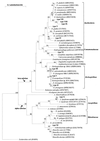16S ribosomal DNA characterization of nitrogen-fixing bacteria isolated from banana (Musa spp.) and pineapple (Ananas comosus (L.) Merril)
- PMID: 11319127
- PMCID: PMC92882
- DOI: 10.1128/AEM.67.5.2375-2379.2001
16S ribosomal DNA characterization of nitrogen-fixing bacteria isolated from banana (Musa spp.) and pineapple (Ananas comosus (L.) Merril)
Abstract
Nitrogen-fixing bacteria isolated from banana (Musa spp.) and pineapple (Ananas comosus (L.) Merril) were characterized by amplified 16S ribosomal DNA restriction analysis and 16S rRNA sequence analysis. Herbaspirillum seropedicae, Herbaspirillum rubrisubalbicans, Burkholderia brasilensis, and Burkholderia tropicalis were identified. Eight other types were placed in close proximity to these genera and other alpha and beta Proteobacteria.
Figures


References
-
- Baldani J I, Caruso L, Baldani V L D, Goi S R, Döbereiner J. Recent advances in BNF with non-legume plants. Soil Biol Biochem. 1997;29:911–922.
-
- Brosius J, Dull T J, Sleeter D D, Noller H F. Gene organization and primary structure of a ribosomal RNA operon from Escherichia coli. J Mol Biol. 1981;148:107–127. - PubMed
-
- Ferreira A C, Cozzolino K, Carvalho A R V, Döbereiner J. International Symposium on Sustainable Agriculture for the Tropics—the Role of Biological Nitrogen Fixation 1995. Rio de Janeirio, Brazil: Angra dos Reis; 1995. Isolation and characterization of diazotrophic bacteria in oil palm trees; p. 210.
-
- James E K, Olivares F L. Infection and colonization of sugar cane and other graminaceous plants by endophytic diazotrophs. Crit Rev Plant Sci. 1997;17:77–119.
-
- Jimenez-Salgado T, Fuentes-Ramirez L E, Tapia-Hernandez A, Mascarua-Esparza M A, Martinez-Romero E, Caballero-Mellado J. Coffea arabica L., a new host plant for Acetobacter diazotrophicus, and isolation of other nitrogen-fixing acetobacteria. Appl Environ Microbiol. 1997;63:3676–3683. - PMC - PubMed
MeSH terms
Substances
Associated data
- Actions
- Actions
- Actions
- Actions
- Actions
- Actions
- Actions
- Actions
- Actions
- Actions
- Actions
- Actions
- Actions
- Actions
- Actions
- Actions
- Actions
- Actions
- Actions
- Actions
- Actions
- Actions
- Actions
- Actions
- Actions
LinkOut - more resources
Full Text Sources
Molecular Biology Databases
Miscellaneous

